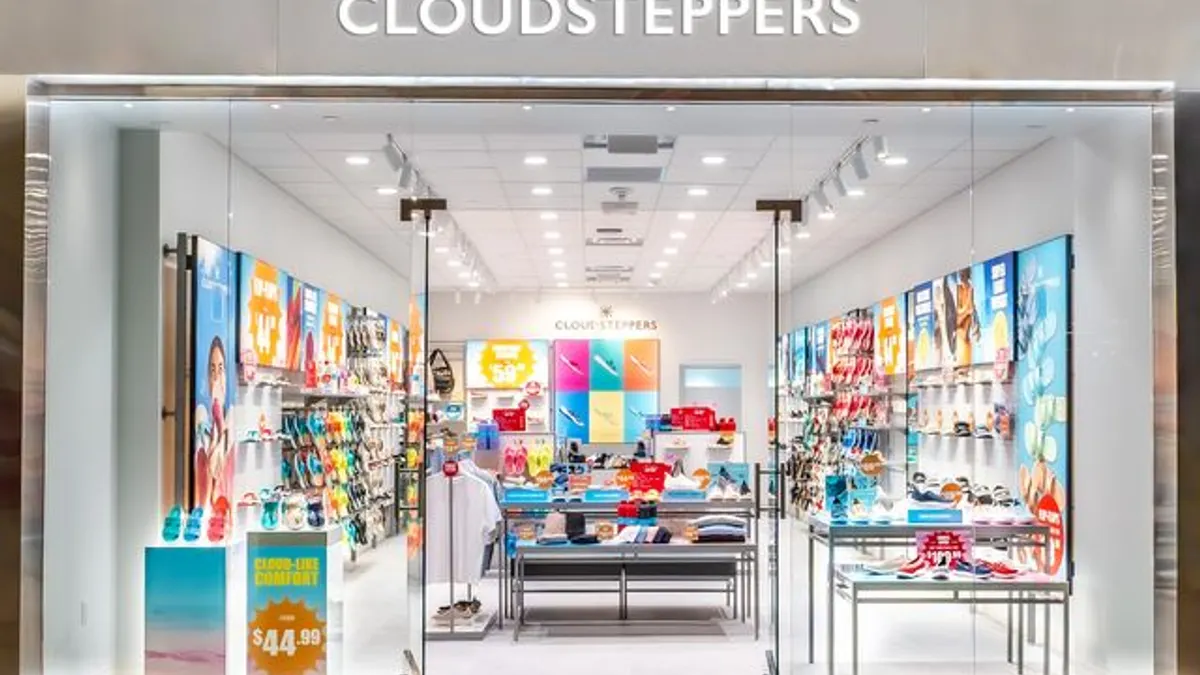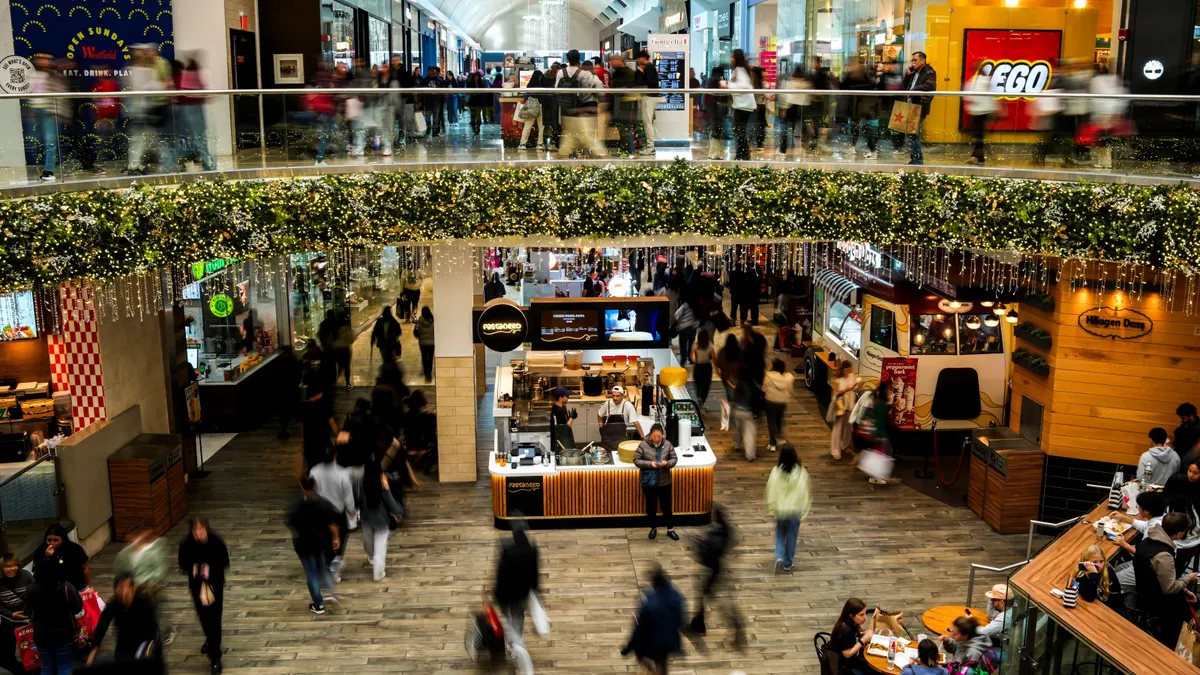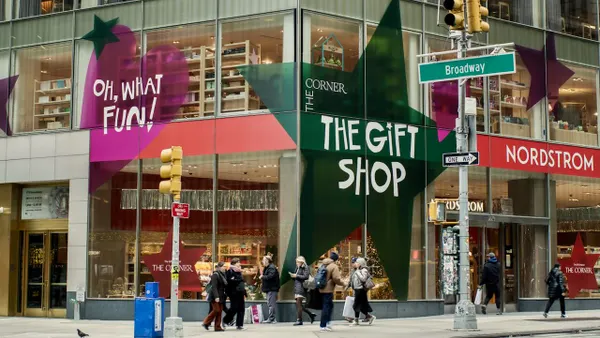Generational marketing operates off of a set of assumptions about a given demographic that dictate what that group might want, and not want, from a given brand. Let's take a family as our example. We've got Jane and Rick, two Gen X parents, a millennial son named Paul, his quickly coming-of-age Gen Z children, and — of course — grandma and grandpa Baby Boomer.
What generational marketing tells us is that whatever Paul wants his grandmother probably won't — and for that reason, marketers appeal to them differently. Maybe Paul is looking for a retail experience that's fun and engaging and his grandmother's just looking to get the most bang for her buck.
But what about Jane and Rick? They're caught in that awkward place between Paul and his grandmother — they're digitally-savvy, they check their email, but they're not as attuned to mobile in the way that Paul and his soon-to-be-consumer children are.
"They're all shaped by their own kind of trends," David Bell, professor of marketing at the Wharton School of Business at the University of Pennsylvania, told Retail Dive. "The baby boomers are all about making money and consuming. I don't think anyone really knows what happened to Gen X. Then the millennials are all about the experience, they're very experience-driven. And lastly you've got the Gen Z's — the really organic digital natives, which are different again."
So how does a retailer navigate the Paul's, Jane's, Rick's and grandmas and grandpas of the world — not to mention the Gen Zers scrambling onto the generational scene? Here are our best insights for how to market to each generation.
Chicken soup for the Gen Z soul
The youngest, most baffling and most desirable demographic is Generation Z. Also known as centennials or "those kids that are poised to overtake retail," every marketer seems to have their eyes on the up-and-comers — and for good reason. The young group accounts for 60 million members of the U.S. population and 2.6 billion worldwide, according to Social Explorer.
There's just one question: how do we reach them?
Gen Z is unlike any other generation in one big way — they value quality over price. In a recent study by Yes Lifecycle Marketing, over half of the group (57%) said that quality affects their brand loyalty the most and 50% said their last purchase was based largely off of the quality of the item. They also value brand prestige more than any other generation, with 11% saying it's important to them.
That goes along with a July study from InMarket, which found that the generation was more likely to buy luxury brands than millennials. Gen Z's willingness to spend more also translates to a larger interest in personalization. Yes Lifecycle Marketing found that 35% of Gen Z look for personalized gifts when buying for others and Erin Gade, a marketing strategist for the company, lists personalization and product recommendations as two "really important" factors for both Gen Z and millennials.
"Showrooms are really good for experience. They're very much an experience and a brand journey, which really resonates with millennials and Gen Z."

David Bell
Professor of Marketing at the Wharton School of Business at the University of Pennsylvania
To that end, showrooms and subscription services do well with Gen Z's and millennials. "Showrooms are really good for experience," Bell said in an interview. "They're very much an experience and a brand journey, which really resonates with millennials and Gen Z."
So Gen Z wants branded experiences — that also means that the younger generation is much more willing to experiment with "out-there" retail concepts than baby boomers. Members of the centennial class want to interact with their favorite brands, and are willing to do so in creative ways. According to the IBM Institute of Business Value and the National Retail Federation, 44% of Gen Zers said they'd be interested in submitting product designs for a brand, 42% would play an online game for a brand campaign and 36% would create digital content for a brand.
Marketers would do well to tailor fun, creative and engaging experiences toward this young group to get the most mileage out of them — especially on mobile apps and social platforms, where Gen Z spends more time and makes more purchases than other generations do. Gen Z's are twice as likely to convert on mobile, twice as influenced by social media as by deals and 80% of them are influenced by social media when making purchases. Clearly, mobile is an avenue that shouldn't be ignored when targeting this group.
"You can say 'we don't want to test that, it's a waste of money,' but if you're not testing things, you're losing out on potential opportunities."

Jason Nesbitt
Vice President of Media and Agency Operations at Strike Social
But just because these marketing techniques work well with Gen Zers doesn't mean retailers shouldn't also test them out with older demographics to see how they respond, Jason Nesbitt, vice president of media and agency operations at Strike Social, told Retail Dive.
"You can say 'we don't want to test that, it's a waste of money,' but if you're not testing things, you're losing out on potential opportunities," Nesbitt said.
Indeed, Bell foresees certain products being successful with both Gen Z and baby boomers, albeit for very different reasons.
"With Gen Z, you might expect they would like something like the extension of a We Work — they might want to do a We Live, where they live in a shared space with others," Bell explained. "On the other end, people who are retired might want that same kind of thing for a different reason. So there might be products that fill value propositions for both of those categories."
Channel preferences:
- Mobile (56%)
- Display advertising (56%)
- Email (46%)
- Social (42%)
Key Fact:
- 59% of Gen Zers are influenced by free shipping offers when making a purchase
The millennials among us
The experience generation, also known (less-interestingly) as millennials, has given rise to several trends in retail. Fung Global Retail and Technology attributes the growth of athleisure to the millennial and Gen Z markets, with those groups showing the most interest in wearables (69% of all users are of those age groups) and the most willingness to spend on wellness classes and products (millennials spend a quarter of their disposable income on health products and services).
That's not to mention subscription services, some of retail's buzziest new offerings, which have flourished mostly thanks to millennials, along with e-commerce players gone brick-and-mortar, like Indochino, Warby Parker, and Bonobos (acquired by Walmart earlier this year).
These showroom-like spaces, which allow customers to try on products and then order online or through other platforms, deliver personalized, often tech-savvy experiences that younger consumers can't seem to get enough of: 38% of millennials are looking for unique gifts when they're out shopping, per Yes Lifecycle Marketing.
"You get the opportunity for experimentation and customization, which are more of a millennial thing," Bell said about subscription services. "The thing I get will be different from the thing you get, so it has an additional level of customization that is right on trend for millennials."
"We've seen a lot of retailers have to shutter a ton of stores and when I think about them, I can't remember what the hell they sold that was special at all."

Lauren Bitar
Director of Retail Consulting at RetailNext
Indeed, differentiation is key for reaching these younger demographics, who expect more from the retailers they're purchasing from than older generations do. Lauren Bitar, director of retail consulting at RetailNext, said that having a unique product is necessary for retailers that don't want to go the same way as many traditional retailers are heading now.
"We've seen a lot of retailers have to shutter a ton of stores and when I think about them, I can't remember what the hell they sold that was special at all," Bitar said.
Millennials might just be worth the extra effort, though. According to Yes Lifecycle Marketing, millennials are the most likely of any generation to remain loyal to a brand because of their loyalty rewards programs (22%) and the company's reputation/philosophy (15%), with 15% saying loyalty points influenced their most recent purchase.
They're looking to form deep connections with the brands that they purchase from — and that's a two-way street. The Fashion Institute of Technology found that 48% of millennials are more likely to buy from a brand if they know the people behind it and 47% express a desire for brands to take ownership of their mistakes and respect consumer feedback.
"Today, I see an advertisement on TV, I become aware of the product, I look for online reviews on it, and then I buy it. There's an extra step now."

Luca Cian
Assistant Professor of Marketing at the Darden School of Business at the University of Virginia
Gade expects loyalty programs to continue to be a draw for millennials, and eventually become one for Gen Z as well, making it all the more pertinent that retailers examine their loyalty offerings.
"Having an actual loyalty program and not just calling it a loyalty program when it's a rewards program, but actually developing a loyalty program with an experience element that makes millennials want to stay with you is really important," Gade said. "I think retailers are moving more toward reinventing their loyalty programs because of what an effect millennials have in that category."
Despite their desire for personalization, millennial shoppers are actually torn between price and quality when they go out shopping, with 34% citing either price or quality as their main driver. Retailers looking to appeal to the group should be sure to highlight those factors, as well as paying close attention to how their products are being received online.
Luca Cian, an assistant professor of marketing at the Darden School of Business at the University of Virginia, notes that with the digitally-savvy generations, advertising has to take a different approach — one that pays attention to the online world where everyone is doing their research.
"Once upon a time, I see an advertisement, I get up and I buy it," Cian said, talking about traditional advertising. "Today, I see an advertisement on TV, I become aware of the product, I look for online reviews on it, and then I buy it. There's an extra step now."
Channel Preferences:
- Email (67%)
- Mobile apps (61%)
- Social media (50%)
Key Fact:
- Ease of transaction is most important for millennials when purchasing via email (88%)
The forgotten generation (X)
It seems no one really knows what happened to Gen X — or whether their marketing department should be targeting them. With the onslaught of excitement over the two youngest generations, Gen X has been left relatively by the wayside — viewed by retailers as not hip enough for social media but maybe too young for direct mail. So how do you target a group that seems to have no identity?
To start with, social isn't just for Gen Z. A study by OnBuy.com that was emailed to Retail Dive found that Generation Xers were highly active online, with 56% of the generation searching for reviews and recommendations before purchasing an item and 49% saying they prefer to leave feedback on a retailer's website.
"Although millennials and Gen Z are the biggest social consumers, other generations are on those platforms too," Gade says of social media. "And just understanding that those users should be part of your social strategy — you need to target them as well. Obviously not on Snapchat, but definitely on Facebook."
"You know when you used to have the cheese shop or the butcher shop and those all got weeded out by convenience stores? Well now it's almost like the pendulum is swinging back the other direction and people are buying things from whoever does it the best."

Lauren Bitar
Director of Retail Consulting at RetailNext
It's important to note, though, that just having an account isn't enough. Some of the most successful brands on Pinterest, which include Whole Foods, Burberry and L'Oreal Paris, are using the platform in more personal ways. According to Econsultancy, brands doing well on Pinterest use the site to post lifestyle marketing content, as well as more personalized material that reaches out to a niche audience.
In addition to acknowledging Gen X's online presence, retailers can go far with this group by highlighting low prices. Yes Lifecycle Marketing found that price was the most important factor for Gen X, with 85% saying discounts or deals influenced their last purchase. While millennials are as influenced by price as they are by quality, Gen Xers are more price-savvy (44%) than quality-driven (25%), although quality does still play a role.
As quality becomes more important, even for the older generations, consumers are less likely to go to one store for all of their needs and instead choose from a variety of stores that offer high-quality products for the best prices.
"Maybe millennials spend more on consumption or the consumption of experiences, but I think if you ignore those older groups altogether, you're giving up a really good economic opportunity."

David Bell
Professor of Marketing at the Wharton School of Business at the University of Pennsylvania
"You know when you used to have the cheese shop or the butcher shop and those all got weeded out by convenience stores?" Bitar said. "Well now it's almost like the pendulum is swinging back the other direction and people are buying things from whoever does it the best."
While millennials and Gen Zers are thought of as the key demographics for this type of personalized, high-quality retail, Bell warned that ignoring the older generations is dangerous — especially where more pricey products are concerned.
"If you go into Gen X or baby boomers, those two groups are the ones that have the most dispensable income," Bell argued. "Maybe millennials spend more on consumption or the consumption of experiences, but I think if you ignore those older groups altogether, you're giving up a really good economic opportunity."
Channel Preferences:
- Email (59%)
- Not really interested in other channels
Key Fact:
- 'Excellent customer support' is the biggest attribute which drives Gen X loyalty (66%)
A booming, captive audience
Baby boomers are in the position of most power as a consumer group — with spare money to spend and brand loyalty that's given to whoever makes life most convenient. Aside from shopping for themselves, a lot of boomers also have children and grandchildren to spoil, meaning they might be more willing to splurge on a birthday or Christmas gift that the youngins can't afford.
As a demographic, the brand loyalty of baby boomers is most driven by price (62%), convenience (30%) and product variety (21%) — all categories that boomers value more than other generations, according to Yes Lifecycle Marketing. Baby boomers are also more likely to factor in whether an item meets their immediate needs (25%) than any other generation.
"In terms of what those generations really value, they value kind of the ease of doing business in terms of your website or mobile presence," Gade said of Gen X and boomers. "Making your experience really seamless and easy to transact with is really one of the elements that they value."
Baby boomers are also a surprisingly engaged audience online. They respond well to email, according to Gade, although marketers should keep in mind that they tend to check emails in the morning and at night, as opposed to the around-the-clock engagement of Gen Z — and it's not just the antiquated email platforms boomers are responding to.
"You cannot give the impression that the store is hip and cool and young and then you go in the store and it smells old or the lights are boring."

Luca Cian
Assistant Professor of Marketing at the Darden School of Business at the University of Virginia
A study by Strike Social found that users over 45 were actually more likely to watch ads on YouTube than younger demographics were — something that Nesbitt said is a huge growth opportunity for retailers.
"Being unwilling to expand your demographics is going to hurt you," Nesbitt said, explaining that baby boomers are essentially a captive audience for YouTube ads and that marketers shouldn't limit the content they use just because they think it won't perform well. "You can easily shift things around if something's not working the way you want it to. But being able to do a ton of testing is a huge, huge opportunity for brands here."
According to Nesbitt, brands can afford to be a little experimental with what kinds of products will appeal to baby boomers and shouldn't be afraid to test the waters. That being said, Cian emphasizes how important it is for retailers to keep sight of who their audience is and cater their brand's message around a unified theme — even when that means isolating one or more generations.
"You cannot give the impression that the store is hip and cool and young and then you go in the store and it smells old or the lights are boring," Cian said, explaining the importance of a brand identity. "A kid doesn't want to drive the same car as their grandparents, they don't want to dress the same way as their grandparents, they don't even want to eat the same food as their grandparents — if you try to sell the same thing to everyone, that's very difficult," he later added.
Channel Preferences
- Direct mail (59%)
- Email (59%)
- Social Media (19%)
Key Fact
- Ease of transaction was the highest driver for making an email purchase (92%)






















